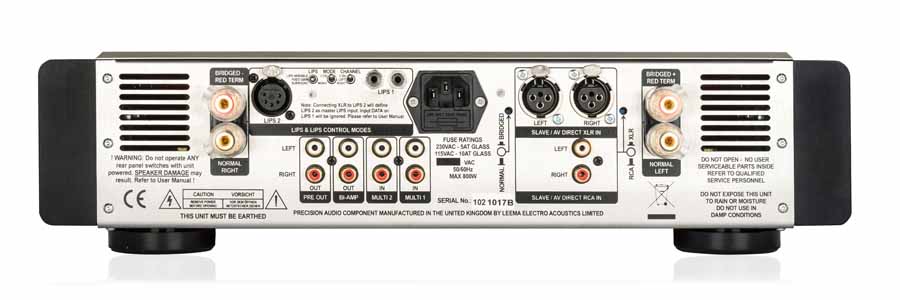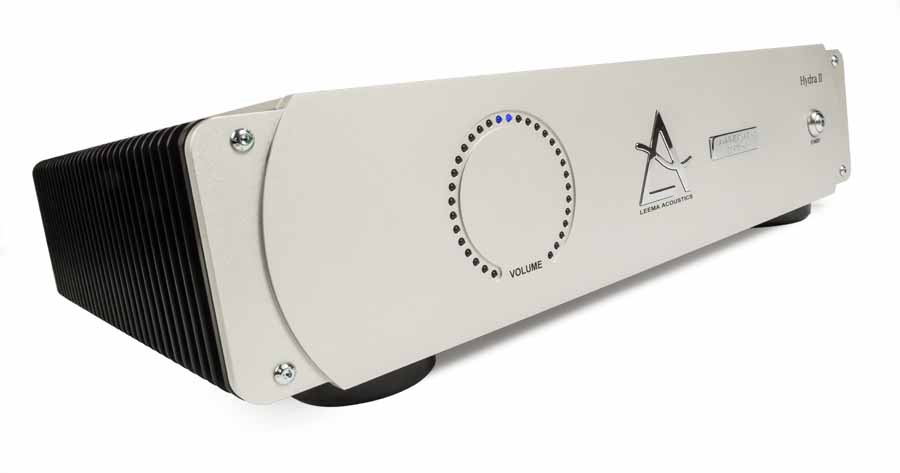Made in Wales the Leema Hydra II Anniversary Edition power amplifier is an updated and upgraded version of the company’s popular power amp. Janine Elliot takes it for a whirl.
 So many good things have emanated from the BBC; Spendor, Harbeth, Trilogy and PMC, to name but a few. Just as the names Spendor and Harbeth are portmanteau words, that is parts of real names (SPENcer Hughes and wife DORothy, and Dudley HARwood and wife ElizaBETH) so too Leema is a word made up of its founders Lee Taylor and Mallory Nicholls, both also ex-BBC engineers. And, just as Spendor, Harbeth and PMC were companies set up to develop speakers beyond what was currently available so, too, Leema Acoustics was originally founded in 1998 as a means of developing a loudspeaker, the Xen (review here), a project that took some 4 years of intense work. They are perhaps better known, though, for their amplifiers and distinctive looking cabinets. The first of which was the Tucana integrated amplifier, released early in 2006. The following year the company began working with a local Welsh electronics manufacturer. In 2014 the two companies decided to join forces working under the same roof. I have always been interested in following this company, not just because I am ex- BBC myself, but particularly their approach to producing some world-class products that not only sound excellent but also look as good as well.
So many good things have emanated from the BBC; Spendor, Harbeth, Trilogy and PMC, to name but a few. Just as the names Spendor and Harbeth are portmanteau words, that is parts of real names (SPENcer Hughes and wife DORothy, and Dudley HARwood and wife ElizaBETH) so too Leema is a word made up of its founders Lee Taylor and Mallory Nicholls, both also ex-BBC engineers. And, just as Spendor, Harbeth and PMC were companies set up to develop speakers beyond what was currently available so, too, Leema Acoustics was originally founded in 1998 as a means of developing a loudspeaker, the Xen (review here), a project that took some 4 years of intense work. They are perhaps better known, though, for their amplifiers and distinctive looking cabinets. The first of which was the Tucana integrated amplifier, released early in 2006. The following year the company began working with a local Welsh electronics manufacturer. In 2014 the two companies decided to join forces working under the same roof. I have always been interested in following this company, not just because I am ex- BBC myself, but particularly their approach to producing some world-class products that not only sound excellent but also look as good as well.
CONSTRUCTION
The Hydra II Anniversary Edition is in effect the Tucana II AE integrated amplifier without a volume control. That amplifier has won respect from the audio press over the last few years, with one magazine putting it as important a product in the history of audio as the PMC Cor, Naim 32/Snaps/250, Mission Cyrus One and A&R Cambridge A60, to name four. The Hydra II Aniversary Edition (£4795) is an updated version of the Hydra II (£3795) now some 10 years old, modified by co-founder Lee Taylor, including a new front panel machined and chrome plated and made from a solid billet which has the Delta logo and an “Anniversary Edition” badge on it. The top has drilled holes in the shape of the Leema logo that act as air vents. Additionally, the printed circuit boards inside have been uprated with twice the amount of copper to reduce the resistance of PCB traces and improve power delivery. The circuitry also uses Nichicon MUSE series capacitors, and internal wiring now uses Leema’s Reference 2 cable which features no less than 16 woven cores plus multi-strand high-purity copper with individual strand silver-plate. Additionally, all the transistors are hand selected and matched in amplifier sets for optimal performance and the lowest distortion. The power amplifier transformers are Noratel units in order to ensure perfect power delivery free from hum or excessive heat generation.
The Hydra II Anniversary is a bridgeable dual mono Class A/B design with two power transformers for each channel plus a third transformer for the control circuitry, that way completely isolating the microprocessor from the audio path. It also has full LIPS (Leema Intelligent Protocol System), which is Leema’s own communication system for use with other Leema products, controlled via a single XLR or 3.5mm sockets. Three small switches on the rear of the unit plus an excellent instruction manual help you to select the correct combination. Indeed, the writing next to the switches is so small (for me!) that the instruction manual is very handy. So many manufacturers fail on their instruction books, and I often see loose A4 sheets or all the information tightly squeezed onto a single sheet, it is a delight to have a full colour 28 page A5 instruction manual that tells you everything you ever need, including technical discussion.
Whilst the simplicity of the front of the Hydra II AE gives it a chunky beauty. The back of the amplifier is covered in sockets including balanced XLR and unbalanced RCA inputs. To select either of these is an intentionally hard-to-get-at recessed pushbutton. There is similarly a recessed pushbutton for selection of either stereo amp or bridged mono-block operation. Whilst I get what they are trying to do, I would actually rather it was easier to access these switches. Funnily enough, the three tiny switches to select LIPS operation or mono left or right could easily be knocked when reaching to the back of the unit to do some pluggery. Other RCA sockets offer pre-out, bi-amp out and multi-channel inputs, plus the speaker binding points accept all common connectors. The whole weighs in at 18kg and offers 150W into 8Ω (290W into 4Ω), more than enough for the power-hungry audiophile, and incorporating many ideas from their reference mono-block, the Altair IV.
THE LISTENING
Turning on the unit was a pleasure. Not only that the knob is on the front rather than on the back (I like easy access!) but that the Leema was very quiet in operation. What is confusing is that when the unit is switched off but connected to the mains the on/off knob actually glows blue but then goes out as soon as you turn on the amplifier. At that point, the top two LEDs on the large circle of blue LEDs lights up to show that the unit is now switched on. Confused? If I used LIPS controlling the amplifier from another source then the circle of LEDs would indicate the appropriate level set. I just wish the LEDs would at least do a quick song and dance when you switch it all on, like my car’s speedo! The LED dial does, however, do an anticlockwise roll when it switches off, which is pretty. Enough of distractions, what I needed to do was listen to my music.
My first source was actually my Krell KPS20i CD player, an excellent source despite being 16bit. I played Max Richter’s “Memoryhouse” album that I used in an earlier review, so I could compare notes. This album is pure Philip Glass minimalism with bits added to thicken it all up. Its ethereal beginnings – and indeed most that follows it – gave me a chance to take in not only the atmosphere but the positions of the instruments; violin, cello, piano, glockenspiel, sound effects etc. I have to say immediately that this was one of the best performances of this album I have yet played, being highly engaging, giving me a chance to get close to all that is going on. The speed of transients without any distortion and the precision of pace and timing was a pleasure to listen to. Sometimes Class A designs can make the music unreal, like when you add too much contrast on your TV picture, but this Hydra was set just right, being very honest in all that it played. Indeed, I actually listened to the whole album. I don’t often do that. Then I survived a few tracks of my own album ‘Boxed In’ as I wanted to hear how close it was to the original that I knew so well. It wasn’t too far from the truth, just a slight sibilance in the vocal. The violins had space and depth to the sound with clarity from the percussion adding to the gentle piano.
Next, I set to listening to LPs with good frequency response and energetic delivery in order to test the precision and dynamism of delivery. Initially, it was STSs Harbour Jazz-band, recorded live on the professional Philips tape recorder loved by the company at the XFI Premium Audio Show. This jazz band have been around since 1956 playing music including Count Basie, Glenn Miller and Louis Armstrong, to name but three. This album is notably punchy and extremely well mic’d for a live concert (including audience applause; often live recordings don’t provide a separate microphone for this important contribution!) There was an excellent presentation on hi-hat and trumpets with the Leema producing an honest rendition with just enough punch to give it a very believable performance, being totally in control of all that was thrust its way. Playing Pink Floyd’s ‘The Division Bell’ gave me a chance to test its Class A/Balls. Everything was there just as it should be, being more controlled though not quite as exciting as my own Krell powerhouse. The Hydra is rated at 150W RMS 8Ω which should be good enough for even the most neurotic speaker, but if you really want oodles of bite, and particularly bass welly you might need to listen with your choice speakers before you buy; the speed and detail really make up for any shortcomings, though.
Turning to ‘Binaural Baroque’ from Mike Valentine’s “Chasing the Dragon”. Vivaldi’s Guitar Concerto sounded articulate, accurate and well-spaced in the room. Even though it is recorded binaurally, more suited for headphone listening, the guitar, harpsichord and strings were quick and well positioned in the sound space, showing that binaural can indeed work through speakers. Continuing with the letter ‘B’ I turned to Brahms 2nd Piano Concerto (Pollini/Vienna Philharmonic orchestra/Claudio Abbado). I have a real fondness these days to play Brahms. I didn’t particularly like the symphonies until I personally got to play them in an orchestra and could understand what the composer was getting at. As a child I also performed much Brahms on piano, particularly wanting to hit those deep chords on a Steinway Model D 9-footer in the music school hall, as they sounded so good. I wanted to hear those deep bass notes through my Wilson Benesch Arc or Graham LS5/9 speakers, and whilst everything was all there it just wasn’t as ‘biting’ and resonant as I wanted it to be. However, the more I listened the more I could hear where Leema were trying to do; that is that the control of the music should take precedence over the power. Controlling the musical performance allowed the timings of notes and speed of delivery to be very real. The piano could breathe in its own space and violins and cellos and wind instruments similarly found their own seats in front and behind the speakers. A test I often do in a review is listening from another room. If it sounds like the musicians are actually in my living room, then it must be good. Some systems make the sound filling the room so unreal. Try this next time you go to a hi-fi show and about to walk in a room. If it sounds like hi-fi and not a live orchestra, then don’t bother entering!
To confirm my findings on the bass I finally turned to ‘Variations’ by Andrew Lloyd Webber, with its deep Moog synthesiser atmosphere-inducing introduction followed by brother Julian playing on the cello. That bass was indeed all there, just not quite as grandiose as I would perhaps like. The detail from the instruments was intense, particularly the percussion and saxophone. Only the mid frequencies showed a slight over emphasis, something I had also noted in an earlier album. In this and in earlier listening the presentation and musicality was almost valve-like but with the detail you expect from transistor. Indeed, turning again to Pink Floyd and the ‘Echoes’ album the well-known track “Time” just sounded a bit too tame. Everything was all there, but very polite and without guts. It was like having a partner who always wants to do everything exactly by the book when you would actually like to take risks. This was a very well behaved performer that just did everything right. Some might, however, want something a little more daring.
CONCLUSION
Hearing a Class-A amplifier with this amount of control and musicality was enlightening, and I very much enjoyed playing the Hydra II AE. It worked on all types of music with enormous detail and sensitivity. Only the bottom end was perhaps too refined for those used to Class-A grunt. Whilst it might not be a bargain in terms of Watts per pound, in terms of delivery of music the Hydra II AE was an absolute bargain.
AT A GLANCE
Build Quality: Externally constructed to a very high standard, typical Leema in style, and with excellent components in the inside including Nichicon MUSE capacitors.
Sound Quality: Excellent speed and accuracy of delivery, with particularly good mids and highs. Grandeur without the grunt.
Value for Money £4795 is excellent value for such a musical producer of sound.
Pros: Very low distortion and noise. Excellent pace and timing. Works on all types of music.
Cons: Some might want more muscle
Price: £4795
Review Equipment:
Pre-Audio turntable/AT33sa cartridge/Manley Steelhead Phono-stage, Krell KPS20i CD, Ferrograph Logic7 15ips/½ track Reel to reel, Wilson Benesch Arc/Torus and Graham Audio LS5/9 speakers with Townshend Supertweeter




















































































































































































































You must be logged in to leave a reply.